Research Hotspots and Frontiers of Product R&D Management under the Background of the Digital Intelligence Era—Bibliometrics Based on Citespace and Histcite
Abstract
:1. Introduction
2. Research Review
2.1. Research and Development of New Products and New Products
2.2. New Product Development Process
2.3. New Product Research and Development Management Methods and Thoughts Combing
2.3.1. Agile Development Philosophy
2.3.2. Lean Production Concept
2.3.3. SGS Doorway Management System
2.3.4. Product Value Management Model
2.3.5. Product and Cycle Optimization Method
2.3.6. Integrated Product Development Method
- Concept and characteristics
- Key factors affecting the implementation of IPD
- Similarities with the agile concept
3. Research Methodology
4. Quantitative Analysis of Related Literature on Product R&D Management
4.1. Research Citation Analysis Based on Histcite
4.1.1. Before 2010
- Case analysis. During this period, because the related theories of product development were still in the exploratory stage, scholars mainly summarized the success and failure cases. Leonardbarton found a paradox between core competence and strict standards in new product development management [21]. Griffin and Page directly evaluated the success and failure of the product development process and recognized that there was no single measurement standard that could measure every product development project [22]. Therefore, after three years, Griffin assumed that the most appropriate set of measurement standards depended on the project and business strategy and design experiments to verify it [23].
- Concept and model. Takeuchi and Nonaka pointed out in the “Harvard Business Review” that new product development is the “new game” that companies will face. Since then, related research in academia has gradually increased. Regarding the research results during this period, Brown and Eisenhardt reviewed it from three aspects: the product development plan, communication network, and solving critical problems [24]. Later, scholars found that integrating different departments improved product development performance in practice and defined product development performance based on this [25]. In further research, Madhavan and Grover found that trust in technical capabilities, information richness, and effective interpersonal communication in the product development process could ensure sufficient knowledge creation capabilities. Moreover, this was also the key driving force of product development, and the authors regarded the process of product development as knowledge management in terms of knowledge embedding and knowledge performance [26]. After more than ten years of research, with the success of the IPD method in IBM, Gerwin and Barrowman conducted an integrated evaluation of the related literature, which provided a theoretical basis for later scholars to study IPD optimization and application [27]. Based on theory and practice, some scholars established models and summarized frameworks to provide theoretical support for subsequent empirical research. Eppinger et al. built a model for the organization of tasks in the product development process [28]. Since there are repeated activities in parallel development, Krishnan et al. built a framework for the management of these repeated activities to reduce time waste and cost loss [29].
- Influencing factors. The marketing department gradually joined the product development process and even led to the development of new products, which was usually facilitated through organization and coordination. Nevertheless, Olson et al. questioned whether cross-departmental teams applied to all types of projects. The author proposed a contingency model based on resource dependence theory and believed that a cross-functional team was more likely to improve development effectiveness when the developed product was entirely innovative. For R&D projects with a low degree of innovation, a relatively bureaucratic structure would achieve better results [30]. Crawford first pointed out the hidden costs in the process [31]. Griffin proposed a measurement method for the product development cycle [32]. Subsequently, Cooper and Kleinschmidt launched a study on the decisive factors of time loss [33]. Four years later, Griffin found, based on previous research, that cross-functional teams played a huge role in shortening the product development cycle, and that the implementation of meticulous and rigorous processes in companies that develop complex products had a more significant impact on shortening time [34].
- Focus on supplier integration. Compared with other stakeholders in the early stages of product development, scholars paid more attention to issues related to suppliers. Handfield et al. proposed that when supplier integration was driven by a process that comprehensively considered supplier capabilities, technical complexity, and risk level, then supplier participation in the strategy could be successful [35]. Ragatz et al. found that in the case of technical uncertainty, incorporating supplier integration into the R&D process as soon as possible could reduce costs and improve efficiency [36]. Subsequently, Petersen et al. empirically found that the increase in supplier knowledge was more likely to lead to a greater degree of information sharing and participation behavior. Technology sharing behavior makes it more able to improve results, thereby alleviating the problems caused by technological uncertainty [37]. Two years later, Petersen et al. once again improved the previous conclusions and examined the relationship between supplier participation in financial performance and product development performance improvement, and comprehensively confirmed the significance of supplier integration for new product development [38].
4.1.2. Nearly 10 Years from 2011 to 2020
- Sustainable development. As the industry’s green transformation has become a general trend, integrating green concepts into the product development process to continuously provide society with green products and solutions is one topic that scholars have been paying attention to over the last decade. Lee and Kim pointed out that green innovation is a critical factor in achieving a win-win situation between the environment and the economy, and achieving green product innovation and development through supplier participation is a strategy that enterprises should give priority to [39]. Through the analysis of eight cases, Driessen et al. pointed out that the greenness of products played a pivotal role in realizing the green transformation of the industry [40]. Through empirical research on the determinants of green product R&D performance, Chen and Chang found that green dynamic capabilities, green transformation leadership, and green creativity could significantly improve product R&D performance [41]. Subsequently, Gmelin and Seuring built a new product development framework for sustainable development based on the life cycle theory and proposed to support the cooperation among them by reducing complexity, coordinating processes and technologies [42]. For integrated product development that considers environmental factors, Poulikidou et al. conducted interviews with a sample of Swedish manufacturing companies and found that they still needed to consider the system integration of environmental requirements in product development decisions [43]. In the second year, Jabbour et al. inspected the green product R&D and performance of Brazilian companies and studied the acceptance of green product R&D (GPD) by technology and organizations. The authors proved that the degree of technology adoption can effectively promote GPD, but that the degree of organizational adoption was affected by uncertainty, and management needed to control the uncertainty to enhance the effect of organizational adoption of GPD [44].
- Pay attention to consumers. Compared with previous studies, scholars are primarily concerned with the impact of supplier participation on product development. In the Web2.0 era, with consumer identity transformation, consumer participation began to play an essential role in the value chain. Scholars also paid attention to this point and carried out research on the subject. Chan and Ip looked at the gradual evolution of product research and the development of market-oriented logic, and found that the relationship between these changes and consumer purchase decisions did not receive attention. Therefore, the authors built a dynamic decision support system (DSS) to predict consumer behavior and define consumer value from the perspective of the life cycle of given products, consumers, and market influencing factors [45]. Djerassi and Decoopman studied how consumer participation played a role in product development in a crowdsourcing scenario [46]. Chang and Taylor proposed a conceptual framework that integrated various accidental factors based on the original analysis method and knowledge management theory. In the conception stage of new product development, customer participation can speed up the time to market and improve financial performance. On the contrary, that is not the case in the development phase. In technologically turbulent new product development projects, emerging countries, low-tech industries, corporate customers, and small companies, the incorporation of customer participation has more significant benefits for new product development performance. On this basis, Cui and Wu further subdivided the types of consumer participation into information resource function (CIS) and co-developer function (CIC). The results showed that, when companies adopted more experimental R&D methods, CIS was more advantageous, and when the R&D process was less experimental, the CIC effect was more substantial, which has important guiding significance for integrating consumer participation in corporate practices.
- New methods of product research and development management. (1) Collaborative product development (CPD). Buyukozkan and Arsenyan conducted a systematic review of CPD and summarized its dynamic development, partnership formation, and infrastructure [47]. They pointed out that trust was the basis of collaborative innovation, discussed the role of trust in selecting new product development suppliers and organizational innovation, and found that business trust was the key to cooperative dependency. However, excessive reliance on trust can lead to incremental innovation, which hinders the organization’s ability to innovate radically [48]. Based on the theory of organizational information, the author examined whether the relationship between the use of IT tools in collaborative product development and the performance of new product development would be affected by the project’s complexity. Three dimensions, namely, product scale, project novelty, and task dependence, verified this hypothesis. (2) Lean product development (LPD). Khan et al. started from a case study of Toyota, Japan, and, through a survey of five companies, found that, although some technologies were used, they were not formally implemented in the organization, and so the authors attempted to define LPD for the first time [49]. Subsequently, Johansson and Sundin further differentiated the concept of LPD by comparing the concepts of LPD and GPD [50]. (3) Agile product development (APD). With the increasing complexity of product development in manufacturing companies, the traditional portal model has exposed its limitations. Thus, Sommer et al. proposed the agile/stage-gate hybrids model and verified it by comparing the cases of seven technology-intensive companies [51]. Subsequently, Cooper, who regarded this as the next development stage of product research and development, demonstrated how to use the model through two large companies [52]. (4) Integrated product development (IPD). Rauner and Rawski explored the impact of the IPD parallel environment on the front-end organizational structure and team structure, and verified the IPD method’s significance through data from the U.S. automotive industry [53].
- Organizational design. Regarding the driving factors of new product R&D performance, most of the literature is considered from the enterprise/team level, and few scholars pay attention to the role of individual ability in the team. The results showed that personal social ability is a crucial factor, among which learning ability is an intermediary and moderating variable, and technical ability and market knowledge are moderating variables of personal social ability and new product performance [54].
- Others. Moreover, we found that there were some other topics of research, such as Acura et al.’s analysis of the role of strategic alignment, which concluded that strategic planning and innovation can have a positive effect on the consistency of technology, market, and product development [55]. Chen et al. conducted an in-depth discussion on the relationship between product development speed and success from the uneconomic time compression, focusing on defining the meaning of product development speed under different uncertain conditions. Finally, an analysis of the source and degree of project uncertainty and the consideration of the team absorptive capacity and customer absorptive capacity to plan the product development time was proposed [56].
4.2. Analysis of the Evolution of Research Hotspots Based on Citespace
4.2.1. Cluster Analysis of Research Topics
4.2.2. Research Hotspot Analysis
4.2.3. Analysis of the Evolution of Research Topics
5. CNKI Literature Analysis of Product R&D Management
5.1. Theoretical Research Analysis of Journal Articles
5.1.1. The Basic Connotation of Product Development Management
- Performance management. The fundamental goal of management is to achieve controllable and increasable performance. Due to the greater risk and uncertainty of product development, product development management must pay more attention to performance management [58]. The performance management of product research and development is based on the research and development process, including the control of product development strategies, the management of new product development costs, the performance evaluation of development team members, and the market performance after new product development.
- Coordinate management. The difficulty of management lies in the effective matching and efficient turnover of resources. Product R&D is an operation process from unfamiliar to familiar, from scattered to a collective, and requires the coordination and cooperation of various workforces, capital, and other production factors, meaning that product R&D requires coordinated management. The coordinated management of product development includes inter-departmental coordinated management, communication management, and management of the entire process.
- Future management. The critical concept of management is sustainable development, which is an extension of operation and management. In an increasingly complex market environment, companies implement product development strategies, mainly in the hope of using product development to maintain their long-term competitiveness and market dynamics, and to drive their development with innovation. In other words, the critical responsibility of product development management for future management is to ensure the long-term competitiveness of the product so that the product does not fall behind competitors and get eliminated from the market in the process of development. The key to ensuring that the product is in line with the market lies in managing knowledge and creativity. Therefore, the future management of product development is mainly based on the management of knowledge and creativity and part of the content of operation management.
5.1.2. Performance Management in Product Development
5.1.3. Coordinated Management in Product Development
5.1.4. Future Management in Product Development
5.2. Thesis Case Application Analysis
- The product development cycle is too long. Defects in the design of the product R&D system, disconnected management systems, and imperfect approval systems, for example, have caused the product development cycle to be too long and delayed, and the R&D personnel, thus, face tremendous pressure;
- The cost of product development is overrun. The company does not attach importance to cost management, does not set a unified or standard basic process, and the cost budget’s accuracy is low. Preliminary cost budget approval for checkpoints often results in project input-output ratios lower than expected, affecting financial performance;
- Insufficient demand analysis. Frequently, user needs are fragmented in the development process, customer needs change quickly, but the front-end communication is not timely. After the samples are produced, customers feel that they are not in line with expectations, which eventually leads to the spread of function development and high rework rate;
- The development process is not in place. Due to the cumbersome process and the inadequate application of synchronization engineering, there are often problems such as process confusion and repeated verification of new products, leading to delays in the previous stage and delays in the entire project. The lack of redundancy of the approval system exacerbates this adverse effect. In some traditional enterprises, outdated R&D systems and management concepts are more obvious;
- The organizational structure is unreasonable. The lack of flexibility in team building, many organizational structure barriers, complicated project progress reporting, and the involvement of many leaders means the project team fails to achieve cross-departmental and cross-functional communication. Likewise, the efficiency of internal and external communication within the team is low;
- There are risks in production quality. The lack of standardized production and operation procedures, and the fact that the factory did not participate in the research and development process in the early stage, quickly caused problems such as unstable product quality and low efficiency in mass production verification.
6. Conclusions, Shortcomings and Outlook
6.1. Conclusions
6.2. Shortcomings and Outlook
Author Contributions
Funding
Institutional Review Board Statement
Informed Consent Statement
Data Availability Statement
Acknowledgments
Conflicts of Interest
References
- Cooper, G.R. Overhauling the new product process. Ind. Mark. Manag. 1996, 25, 465–482. [Google Scholar] [CrossRef]
- Elias, A.A.; Cavana, Y.R.; Jackson, S.L. Stakeholder analysis for R&D project management. R&D Manag. 2002, 32, 301–310. [Google Scholar]
- Herrmann, A.M.; Storz, C.; Held, L. Whom do nascent ventures search for? resource scarcity and linkage formation activities during new product development processes. Small Bus. Econ. 2020, 1, 1–22. [Google Scholar]
- Michael, E. The power of Perth. Shanghai Sci. Technol. Press 2004, 18, 1–16. [Google Scholar]
- Weeth, A.; Prigge, J.; Homburg, C. The role of departmental thought worlds in shaping escalation of commitment in new product development projects. J. Prod. Innov. Manag. 2020, 37, 48–73. [Google Scholar] [CrossRef]
- Carol, N. New Products Development; People′s Posts and Telecommunications Press: Beijing, China, 2015. [Google Scholar]
- Krishnan, V.; Ulrich, K.T. Product development decisions: A review of the literature. Manag. Sci. 2001, 47, 1–21. [Google Scholar] [CrossRef] [Green Version]
- Wang, Y.; Zeng, D.; Chen, J.; Yu, S. Technology convergence, technological turbulence and new product development performance. Stud. Sci. Sci. 2020, 38, 488–495. [Google Scholar]
- Magistretti, S.; Dell’Era, C.; Verganti, R. Look for new opportunities in existing technologies: Leveraging temporal and spatial dimensions to power discovery. Res. Technol. Manag. 2020, 63, 39–48. [Google Scholar] [CrossRef]
- Verganti, R.; Vendraminelli, L.; Iansiti, M. Innovation and design in the age of artificial intelligence. J. Prod. Innov. Manag. 2020, 37, 212–227. [Google Scholar] [CrossRef]
- Simeone, L.; Secundo, G.; Schiuma, G. Knowledge translation mechanisms in open innovation: The role of design in R&D projects. J. Knowl. Manag. 2017, 21, 1367–3270. [Google Scholar]
- Tranfield, D.; Denyer, D.; Smart, P. Towards a methodology for developing evidence-informed management knowledge by means of systematic review. Br. J. Manag. 2003, 14, 207–222. [Google Scholar] [CrossRef]
- Magistretti, S.; Dell’Era, C.; Verganti, R. Searching for the right application: A technology development review and research agenda. Technol. Forecast. Soc. Chang. 2020, 151, 119879. [Google Scholar] [CrossRef]
- Chen, Q.; Ting, Y.; Chang, X. Research on development trends, mode comparison of enterprise product R&D management and its inspirat. Sci. Technol. Prog. Policy 2016, 33, 86–91. [Google Scholar]
- Li, D.; Gao, F.; Li, X.; Gu, Z.; Wei, T.; Xiao, J.; Wang, J.; Feng, X. Research on new product development based on lean: Agile innovation model. Jiangsu Commer. Forum 2019, 4, 95–100. [Google Scholar]
- Cooper, R. The stage-gates idea-to-launch process-update, what’s new, and NexGen systems. J. Prod. Innov. Manag. 2008, 25, 213–232. [Google Scholar] [CrossRef]
- Ingenbleek, P.; Frambach, R.T.; Verhallen, T. The role of value-informed pricing in market-oriented product innovation management. J. Prod. Innov. Manag. 2010, 27, 1032–1046. [Google Scholar] [CrossRef]
- Liang, M. Discussion on integrated product development (IPD). Sci. Technol. Manag. Res. 2010, 30, 120–122. [Google Scholar]
- Balachandra, R.; Nellore, R. Factors influencing success in integrated product development (IPD) projects. Trans. Eng. 2001, 48, 164–174. [Google Scholar]
- Zhang, L.; Suo, Y.; Liu, W. Critical factors of implementing IPD in new product development. Sci. Technol. Manag. Res. 2015, 35, 1–4, 9. [Google Scholar]
- Leonardbarton, D. Core capabilities and core rigidities: A paradox in managing new product development. Strateg. Manag. J. 1992, 13, 111–125. [Google Scholar] [CrossRef]
- Griffin, A.; Page, A.L. An interim report on measuring product development success and failure. J. Prod. Innov. Manag. 1993, 10, 291–308. [Google Scholar] [CrossRef]
- Griffin, A.; Page, A.L. PDMA Success measurement project: Recommended measures for product development success and failure. J. Prod. Innov. Manag. 1996, 13, 478–496. [Google Scholar] [CrossRef]
- Brown, S.L.; Eisenhardt, K.M. Product Development: Past research, present findings, and future directions. Acad. Manag. Rev. 1995, 20, 343–378. [Google Scholar] [CrossRef] [Green Version]
- Kahn, K.B. Interdepartmental integration: A definition with implications for product development performance. J. Prod. Innov. Manag. 1996, 13, 137–151. [Google Scholar] [CrossRef]
- Madhavan, R.; Grover, R. From Embedded Knowledge to embodied knowledge: New product development as knowledge management. J. Mark. 1998, 62, 1–12. [Google Scholar] [CrossRef] [Green Version]
- Gerwin, D.; Barrowman, N. An evaluation of research on integrated product development. Manag. Sci. 2002, 48, 938–953. [Google Scholar] [CrossRef]
- Eppinger, S.D. A model-based method for organizing tasks in product development. Res. Eng. Des. 1994, 6, 1–13. [Google Scholar] [CrossRef] [Green Version]
- Krishnan, V.; Eppinger, S.D.; Whitney, D.E. A model-based framework to overlap product development activities. Manag. Sci. 1997, 43, 437–451. [Google Scholar] [CrossRef]
- Olson, E.M.; Walker, O.C.; Ruekert, R.W. Organizing for effective new product development: The moderating role of product innovativeness. J. Mark. 1995, 59, 48–62. [Google Scholar] [CrossRef]
- Crawford, C.M. The hidden costs of accelerated product development. J. Prod. Innov. Manag. 1992, 9, 188–199. [Google Scholar] [CrossRef]
- Griffin, A. Metrics for measuring product development cycle time. J. Prod. Innov. Manag. 1993, 10, 112–125. [Google Scholar] [CrossRef]
- Capasso, M.; Treibich, T.; Verspagen, B. The medium-term effect of r&d on firm growth. Small Bus. Econom. 2015, 45, 39–62. [Google Scholar]
- Griffin, A. The effect of project and process characteristics on product development cycle time. J. Mark. Res. 1997, 34, 24–35. [Google Scholar] [CrossRef]
- Handfield, R.B.; Ragatz, G.L.; Petersen, K.J. Involving suppliers in new product development. Calif. Manag. Rev. 1999, 42, 59–82. [Google Scholar] [CrossRef]
- Ragatz, G.L.; Handfield, R.B.; Petersen, K.J. Benefits associated with supplier integration into new product development under conditions of technology uncertainty. J. Bus. Res. 2002, 55, 389–400. [Google Scholar] [CrossRef]
- Petersen, K.J.; Handfield, R.B.; Ragatz, G.L. A model of supplier integration into new product development. J. Prod. Innov. Manag. 2003, 20, 284–299. [Google Scholar] [CrossRef]
- Petersen, K.J.; Handfield, R.B.; Ragatz, G.L. Supplier integration into new product development: Coordinating product, process and supply chain design. J. Oper. Manag. 2005, 23, 371–388. [Google Scholar] [CrossRef]
- Lee, K.; Kim, J. Integrating suppliers into green product innovation development: An empirical case study in the semiconductor industry. Bus. Strateg. Environ. 2011, 20, 527–538. [Google Scholar] [CrossRef]
- Driessen, P.H.; Hillebrand, B.; Kok, R. Green new product development: The pivotal role of product greenness. IEEE Trans. Eng. Manag. 2013, 60, 315–326. [Google Scholar] [CrossRef] [Green Version]
- Chen, Y.; Chang, C. The determinants of green product development performance: Green dynamic capabilities, green transformational leadership, and green creativity. J. Bus. Ethics 2013, 116, 107–119. [Google Scholar] [CrossRef]
- Gmelin, H.; Seuring, S. Determinants of a sustainable new product development. J. Clean. Prod. 2014, 69, 1–9. [Google Scholar] [CrossRef]
- Poulikidou, S.; Bjorklund, A.; Tyskeng, S. Empirical study on integration of environmental aspects into product development: Processes, requirements and the use of tools in vehicle manufacturing companies in Sweden. J. Clean. Prod. 2014, 81, 34–45. [Google Scholar] [CrossRef]
- Jabbour, C.J.; Jugend, D.; Jabbour, A.B. Green product development and performance of Brazilian firms: Measuring the role of human and technical aspects. J. Clean. Prod. 2015, 87, 442–451. [Google Scholar] [CrossRef]
- Chan, S.L.; Ip, W.H. A dynamic decision support system to predict the value of customer for new product development. Decis. Support Syst. 2011, 52, 178–188. [Google Scholar] [CrossRef]
- Djelassi, S.; Decoopman, I. Customers’ participation in product development through crowdsourcing: Issues and implications. Ind. Mark. Manag. 2013, 42, 683–692. [Google Scholar] [CrossRef]
- Buyukozkan, G.; Arsenyan, J. Collaborative product development: A literature overview. Prod. Plan. Control 2012, 23, 47–66. [Google Scholar] [CrossRef]
- Bunduchi, R. Trust, partner selection and innovation outcome in collaborative new product development. Prod. Plan. Control 2013, 24, 145–157. [Google Scholar] [CrossRef] [Green Version]
- Khan, M.S.; Alashaab, A.; Shehab, E. Towards lean product and process development. Int. J. Comput. Integr. Manuf. 2013, 26, 1105–1116. [Google Scholar] [CrossRef]
- Johansson, G.; Sundin, E. Lean and green product development: Two sides of the same coin? J. Clean. Prod. 2014, 85, 104–121. [Google Scholar] [CrossRef] [Green Version]
- Sommer, A.F.; Hedegaard, C.; Dukovskapopovska, I. Improved product development performance through agile/stage-gate hybrids: The next-generation stage-gate process? Res. Technol. Manag. 2015, 58, 34–45. [Google Scholar] [CrossRef] [Green Version]
- Cooper, R.G. Agile-stage-gate hybrids: The next stage for product development. Res. Technol. Manag. 2016, 59, 21–29. [Google Scholar] [CrossRef]
- Rauniar, R.; Rawski, G. Organizational structuring and project team structuring in integrated product development project. Int. J. Prod. Econ. 2012, 135, 939–952. [Google Scholar] [CrossRef]
- Yu, L.; Chen, Z.; Yao, P.; Liu, H. A study on the factors influencing users’ online knowledge paying-behavior based on the UTAUT model. J. Theor. Appl. Electron. Commer. Res. 2021, 16, 1768–1790. [Google Scholar] [CrossRef]
- Acur, N.; Kandemir, D.; Boer, H. Strategic alignment and new product development: Drivers and performance effects. J. Prod. Innov. Manag. 2012, 29, 304–318. [Google Scholar] [CrossRef]
- Chen, J.; Reilly, R.R.; Lynn, G.S. New product development speed: To much of a good thing? J. Prod. Innov. Manag. 2012, 29, 288–303. [Google Scholar] [CrossRef]
- Liu, H.; Yao, P.; Wang, X.; Huang, J.; Yu, L. Research on the Peer Behavior of Local Government Green Governance Based on SECI Expansion Model. Land 2021, 10, 472. [Google Scholar]
- Alegre, J.; Lapiedra, R.; Chiva, R. A measurement scale for product innovation performance. Eur. J. Innov. Manag. 2006, 9, 333–346. [Google Scholar] [CrossRef]
- Gao, J.; Liu, L.; Cai, H. The strategic management of R&D for highly technological product. Sci. Manag. Res. 2003, 2, 74–78. [Google Scholar]
- Liu, Y.; Luo, Y. Planning and control of R&D costs for steel enterprises. Enterp. Econ. 2017, 36, 125–130. [Google Scholar]
- Lu, Y. Product R&D management performance audit case. Intern. Audit. China 2014, 8, 55–57. [Google Scholar]
- Zhang, X.; Liu, H.; Yao, P. Research jungle on online consumer behaviour in the context of web 2.0: Traceability, frontiers and perspectives in the post-pandemic era. J. Theor. Appl. Electron. Commer. Res. 2021, 16, 1740–1767. [Google Scholar] [CrossRef]
- Zheng, J.; Fang, C.; Gan, Y. Research on product R&D team member configuration based on knowledge learning. Sci. Technol. Manag. Res. 2019, 39, 135–143. [Google Scholar]
- Deeds, R. Exploration and exploitation alliances in biotechnology: A system of new product development. Strateg. Manag. J. 2010, 25, 201–221. [Google Scholar]
- He, X.; Xiong, J. Research on the relationship between market orientation, creativity and new product development performance. Soft Sci. 2012, 26, 20–26. [Google Scholar]
- Sha, Z.; Zhou, D.; Ji, Q. Mechanism of market orientation on new product development performance. Sci. Technol. Manag. Res. 2013, 33, 104–109. [Google Scholar]
- Tao, X.; Shen, X. The influence mechanism of market learning ability on new product development performance. Sci. Technol. Prog. Policy 2018, 35, 16–22. [Google Scholar]
- Sun, H. Research on team faultlines and innovation performance of new product development teams: The moderating roles of swift trust and knowledge transfer channel. Theory Pract. Financ. Econ. 2015, 36, 126–132. [Google Scholar]
- Yu, X.; Tao, X. An inverted U-Shape relationship between entrepreneurial failure experiences and new product development performance: The multiple mediating effects of entrepreneurial orientation. J. Manag. Sci. 2015, 28, 1–14. [Google Scholar]
- Li, Q.; Jiang, X.; Sheng, Z. A study of the relationship among team trust, shared leadership and innovation performance in new product development organizatio. Sci. Res. Manag. 2019, 40, 292–300. [Google Scholar]
- Zheng, J.; Li, N. Coordination mechanism of product development team for knowledge task. Sci. Technol. Manag. Res. 2019, 39, 115–120. [Google Scholar]
- Zhang, J. Communication in new product development: Research status and future trend. J. Technol. Econ. 2012, 31, 8–15, 100. [Google Scholar]
- Lin, J.; Yan, X.; Cui, W.; Qian, Y. Effects of concurrent and communication strategies on new product development performanc. J. Manag. Sci. 2012, 25, 1–9. [Google Scholar]
- Yang, Q.; Tang, E. Cross-domain integration and optimization of the process and product architecture in product development projects. Syst. Eng. Theory Pract. 2014, 34, 1525–1532. [Google Scholar]
- Jin, N.; Hu, H. Quality gaps and knowledge gaps in a new product development process. Sci. Res. Manag. 2010, 31, 127–133. [Google Scholar]
- Shen, H.; Xie, E.; Wang, D. How environmental uncertainties drive strategic choices and sustainable competitive advantage of new product development. Res. Econ. Manag. 2017, 38, 117–126. [Google Scholar]
- Xue, J.; Zhang, Z. Research on the influence of external knowledge integrative capabilities on product competitive capabilities of green enterprises: Taking green product development capabilities as mediating variables. Sci. Sci. Manag. S&T 2016, 37, 106–116. [Google Scholar]
- Du, X.; Wang, J.; Xia, L. The application of competitive intelligence in the product development of modern enterprises. Acad. J. Zhongzhou 2009, 6, 256–258. [Google Scholar]
- Li, W.; Wen, X.; He, H.; Zhou, B. Research and application of enterprise competitive intelligence business flow based on SGS new product development process. J. Mod. Inf. 2019, 39, 152–158. [Google Scholar]
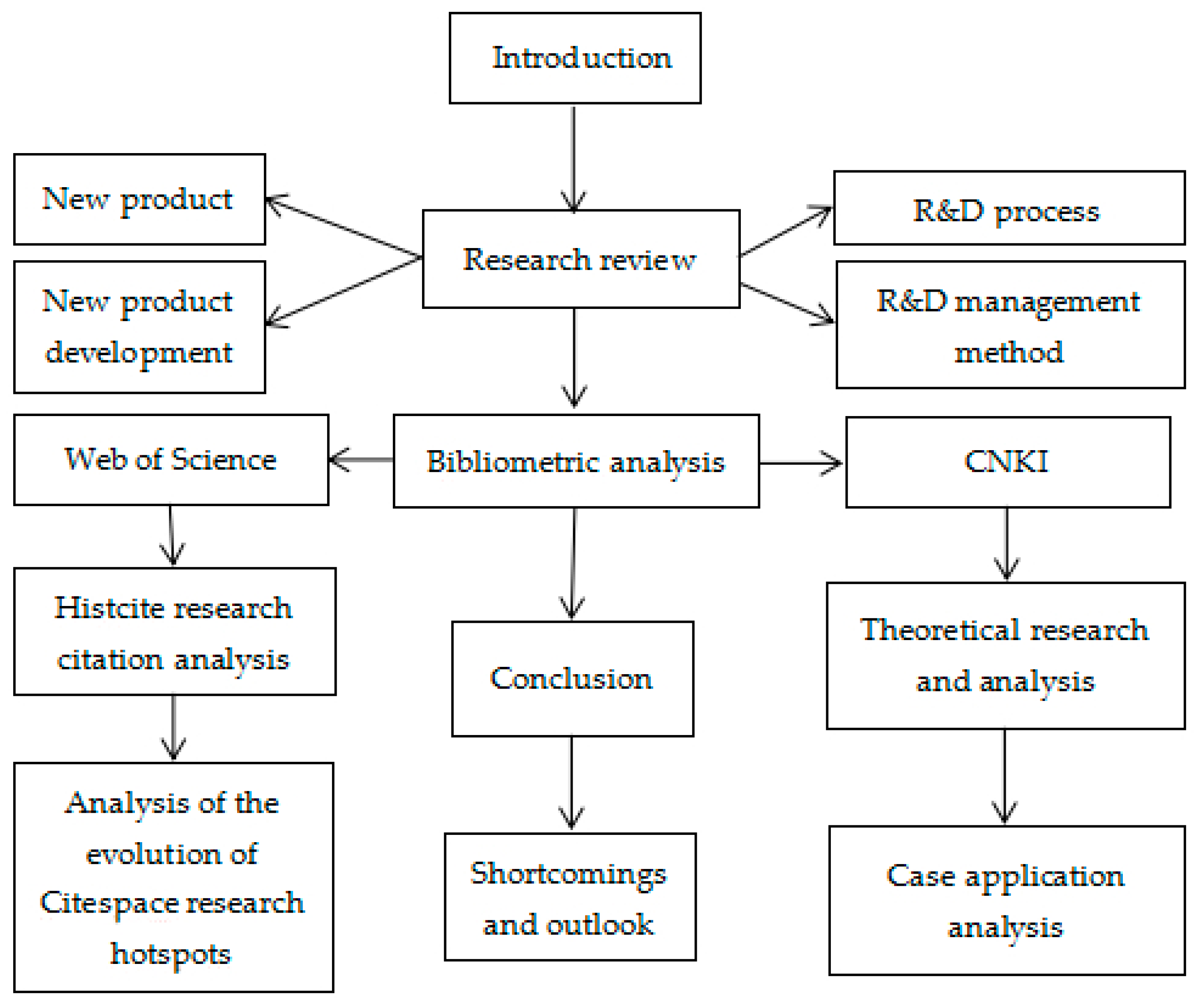
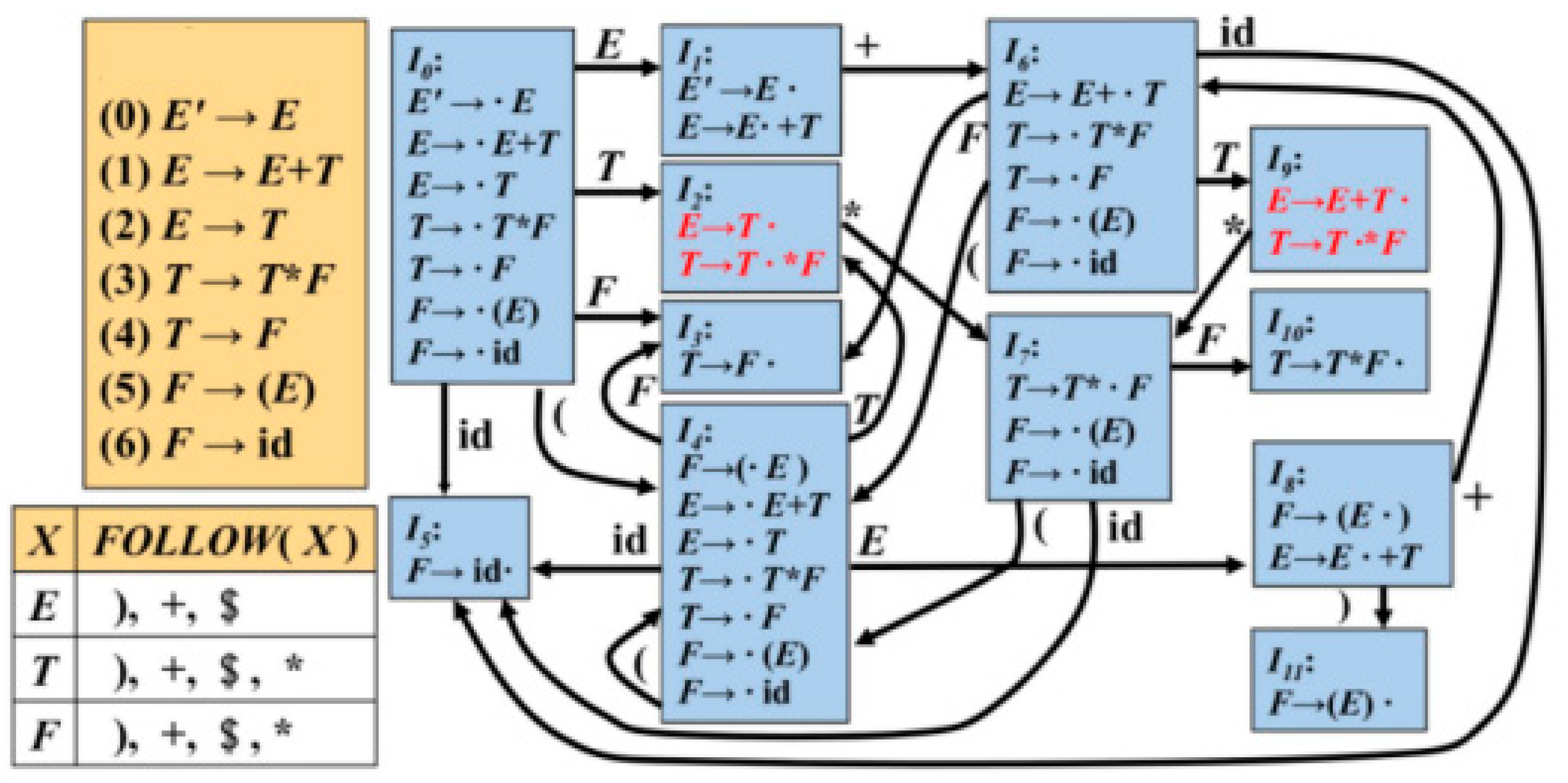
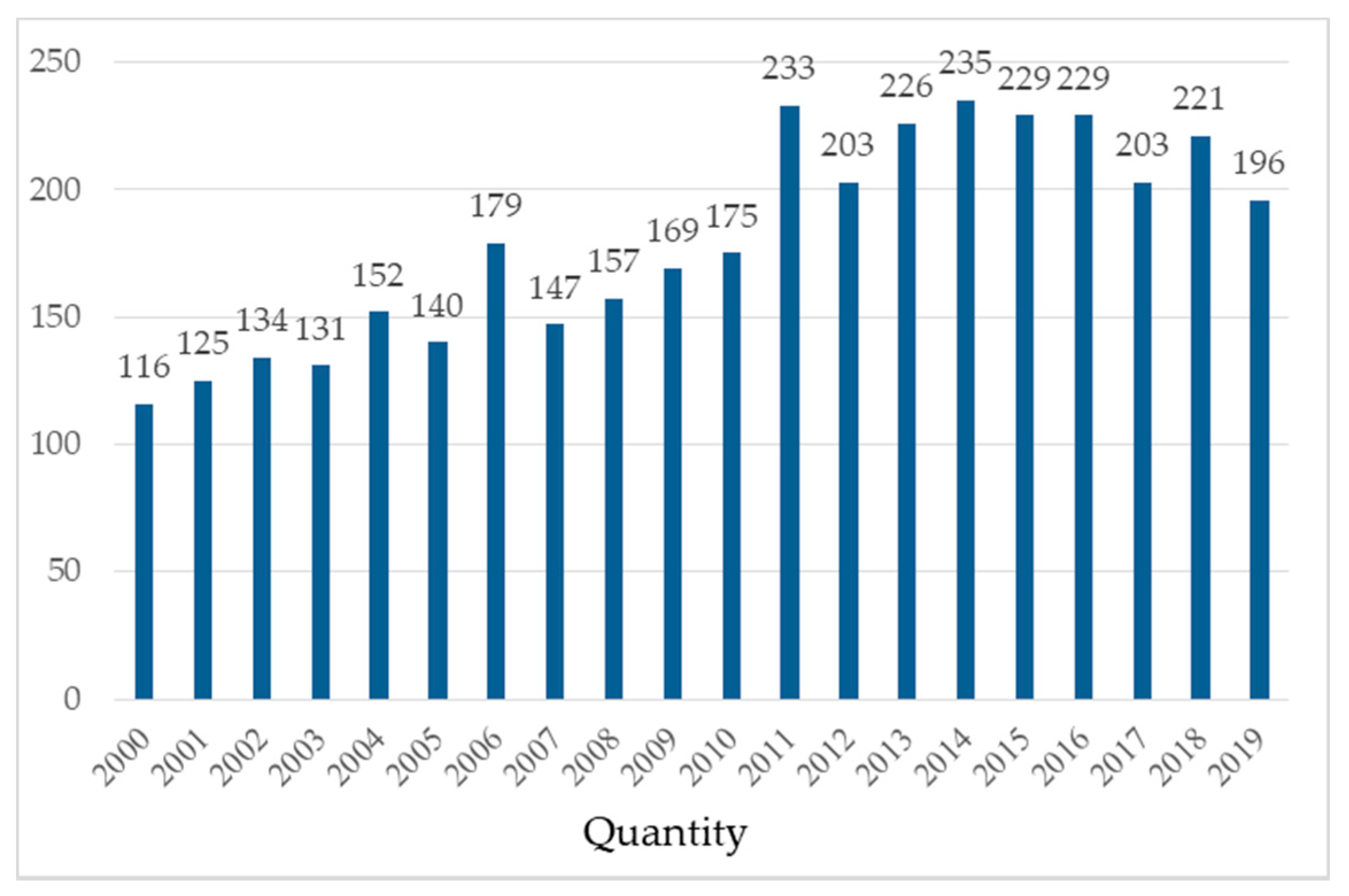
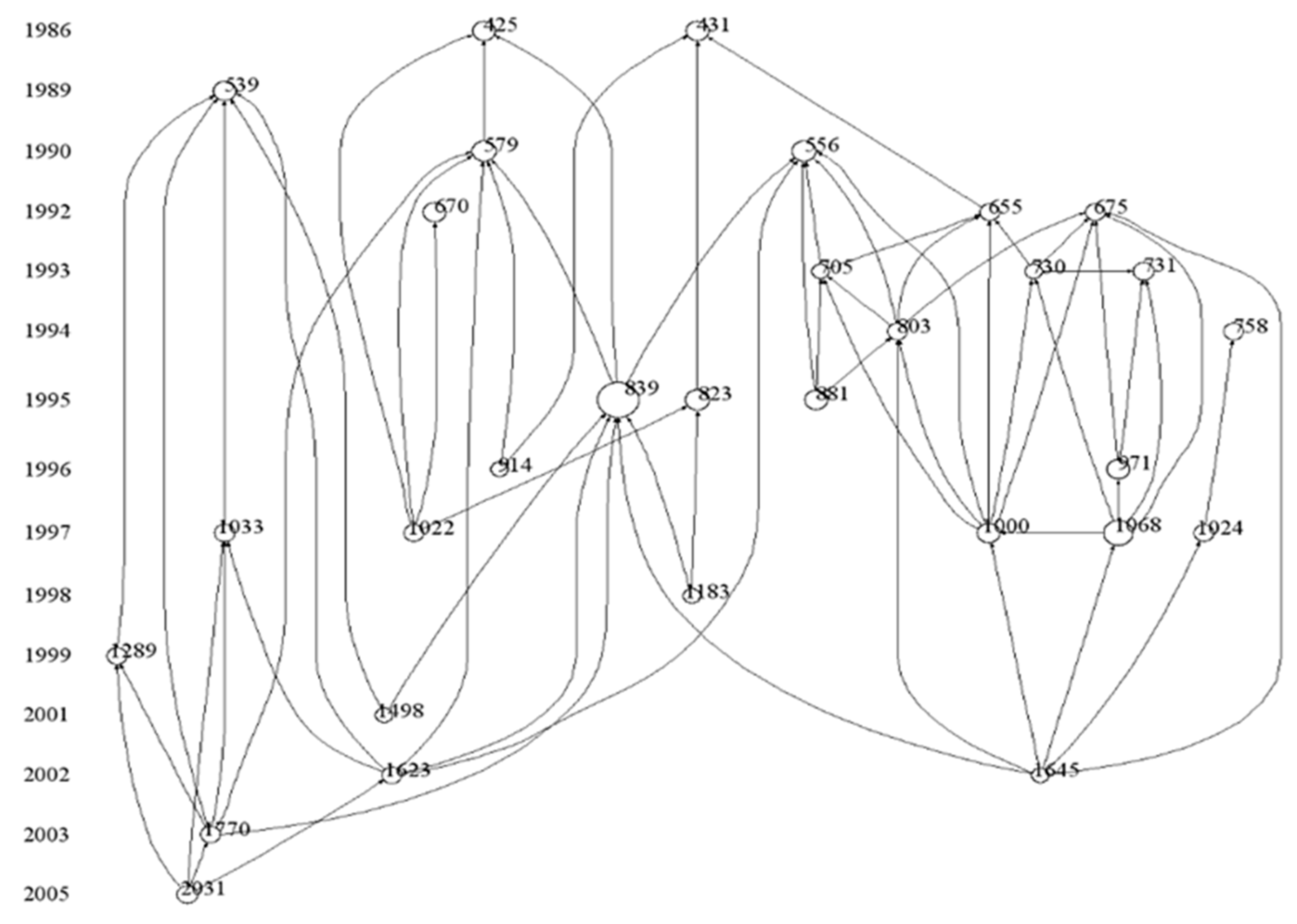

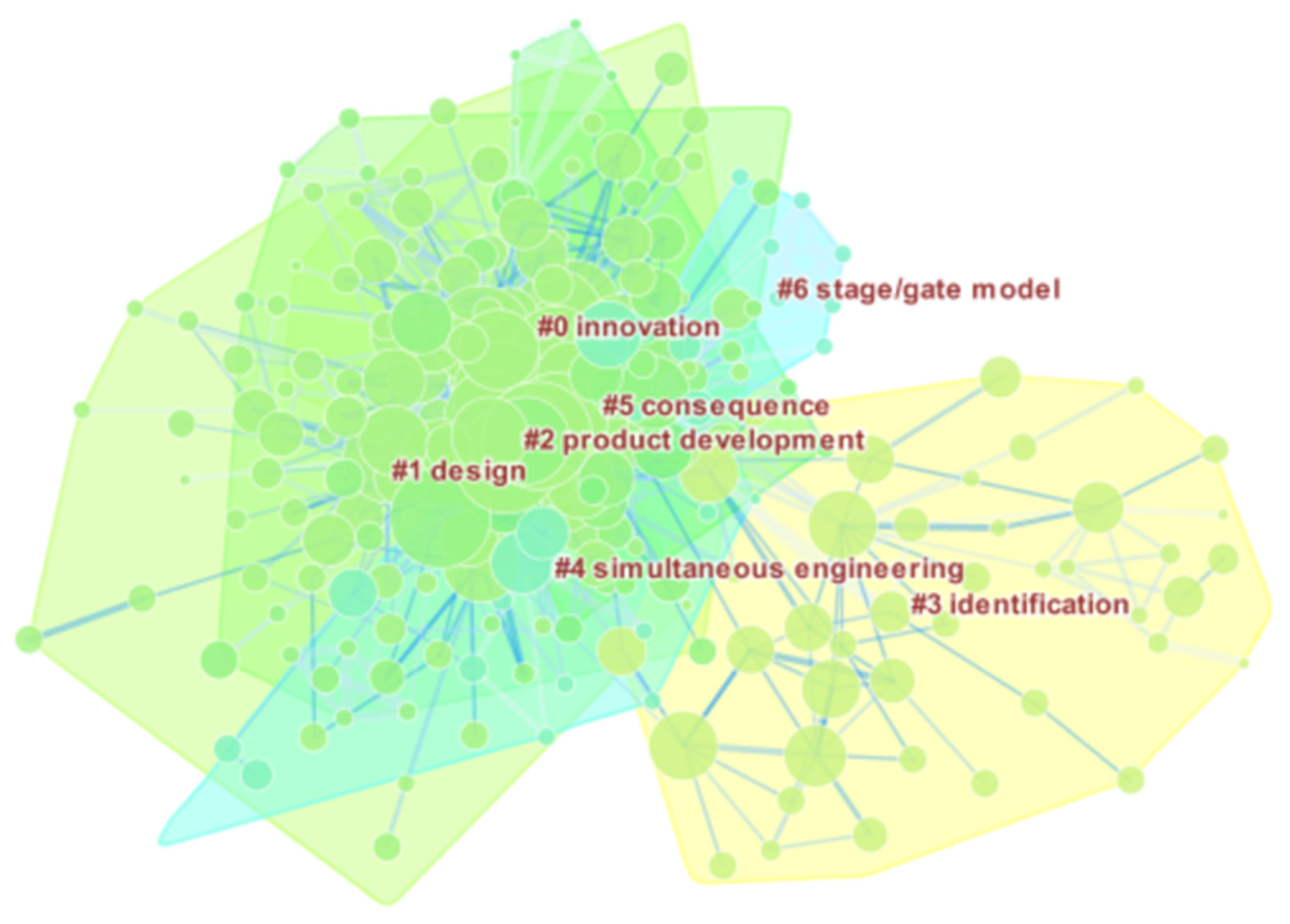

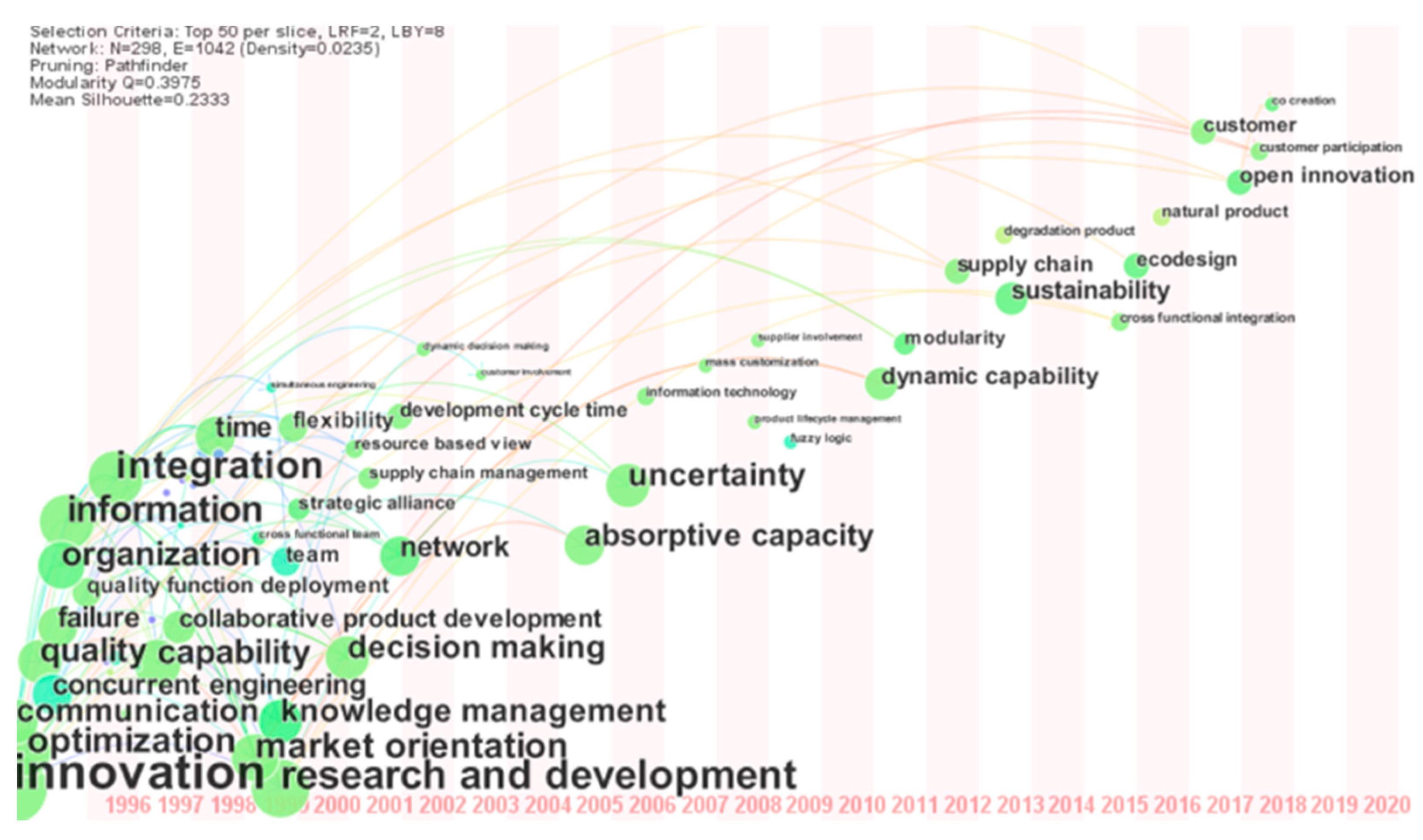
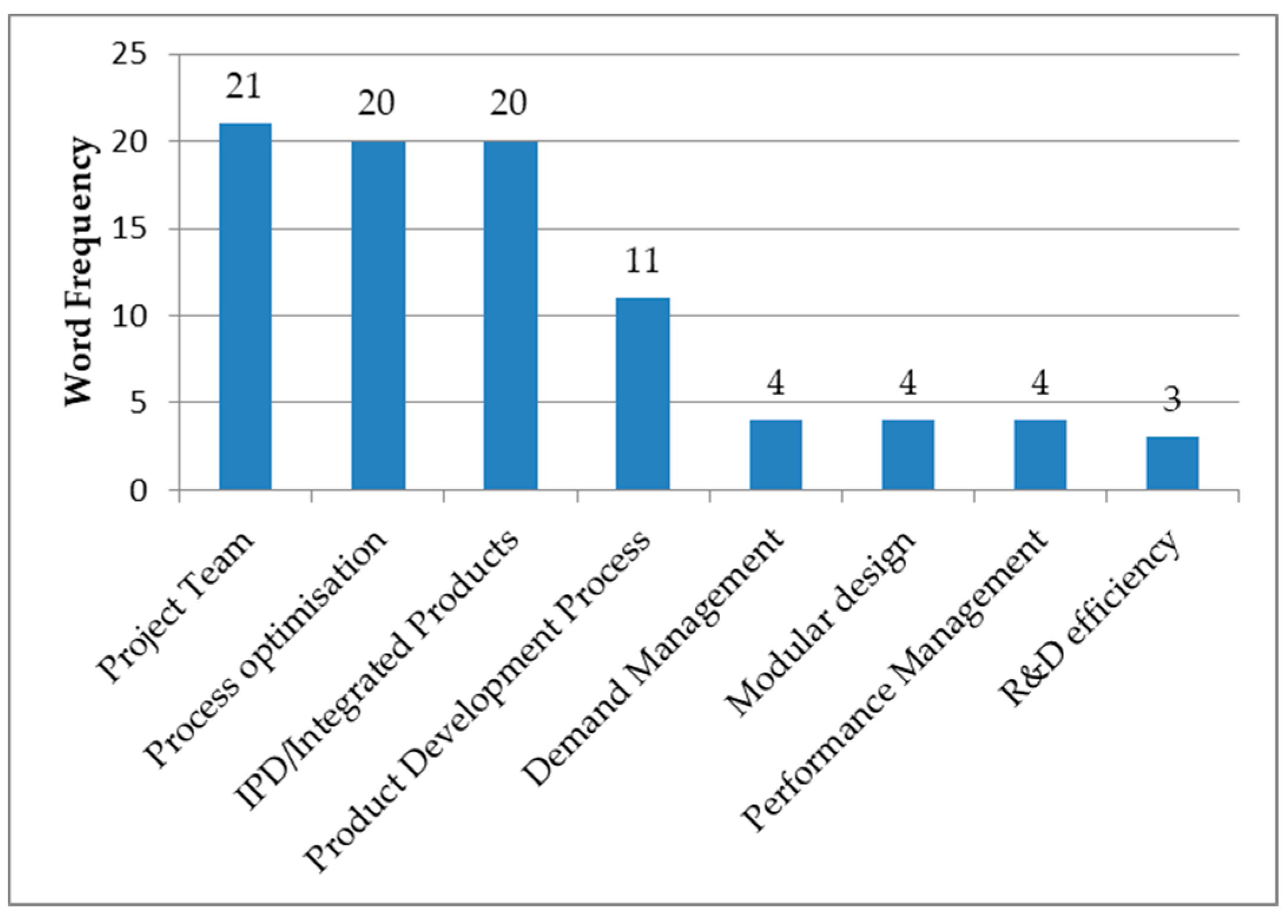
| Theoretical Foundations of Research | Research and development of new products and new products | [6,7,8,9,10,11,12,13] | This paper builds on the theory to structure the entire article. By combing through the literature on new products, new product development, the process of new product development management, and the ideas of new product development management, the paper uses the Histcite and Citespace tools to summarise and organise research hotspots and methods, and to discover the patterns of change in the historical process of product development. |
| New product development process | [3,4,6,8,14] | ||
| New product research and development management methods and thoughts combing | [14,15,16,17,18,19,20] | ||
| Research Methodology | SLR | [12] | The SLR literature analysis method is suitable for research areas where the structure of the field is well defined and where there are no conflicting parts. The research on product development hotspots in the digital intelligence era is relatively new, and Histcite is more effective for rapid access to unfamiliar areas and achieving universal literature analysis. Supported by scientometrics and data visualization, Citespace can complement Histcite’s historical presentation capabilities. |
| Cluster ID | Size | Silhouette | Mean (Year) | Label (LLR) |
|---|---|---|---|---|
| 0 | 65 | 0.594 | 2002 | Innovation |
| 1 | 54 | 0.529 | 2003 | Design |
| 2 | 46 | 0.568 | 2004 | Product development |
| 3 | 42 | 0.891 | 2005 | Identification |
| 4 | 20 | 0.724 | 1999 | Simultaneous engineering |
| 5 | 12 | 0.808 | 1998 | Consequence |
| 6 | 9 | 0.869 | 1997 | Stage/gate model |
Publisher’s Note: MDPI stays neutral with regard to jurisdictional claims in published maps and institutional affiliations. |
© 2021 by the authors. Licensee MDPI, Basel, Switzerland. This article is an open access article distributed under the terms and conditions of the Creative Commons Attribution (CC BY) license (https://creativecommons.org/licenses/by/4.0/).
Share and Cite
Liu, H.; Luo, Y.; Geng, J.; Yao, P. Research Hotspots and Frontiers of Product R&D Management under the Background of the Digital Intelligence Era—Bibliometrics Based on Citespace and Histcite. Appl. Sci. 2021, 11, 6759. https://doi.org/10.3390/app11156759
Liu H, Luo Y, Geng J, Yao P. Research Hotspots and Frontiers of Product R&D Management under the Background of the Digital Intelligence Era—Bibliometrics Based on Citespace and Histcite. Applied Sciences. 2021; 11(15):6759. https://doi.org/10.3390/app11156759
Chicago/Turabian StyleLiu, Hongda, Yuxi Luo, Jiejun Geng, and Pinbo Yao. 2021. "Research Hotspots and Frontiers of Product R&D Management under the Background of the Digital Intelligence Era—Bibliometrics Based on Citespace and Histcite" Applied Sciences 11, no. 15: 6759. https://doi.org/10.3390/app11156759
APA StyleLiu, H., Luo, Y., Geng, J., & Yao, P. (2021). Research Hotspots and Frontiers of Product R&D Management under the Background of the Digital Intelligence Era—Bibliometrics Based on Citespace and Histcite. Applied Sciences, 11(15), 6759. https://doi.org/10.3390/app11156759






